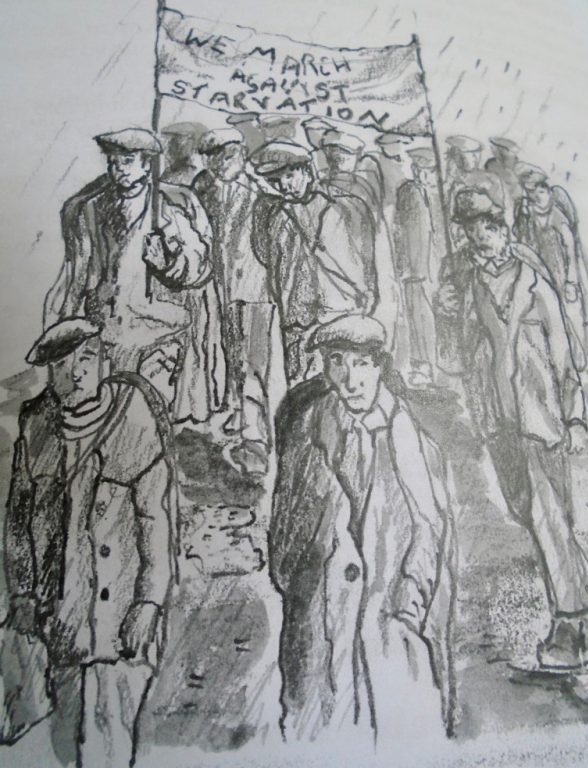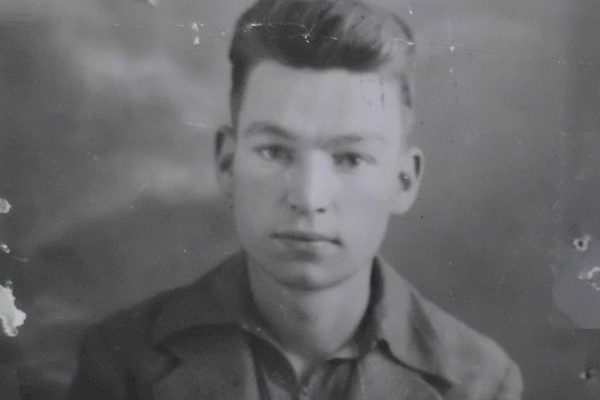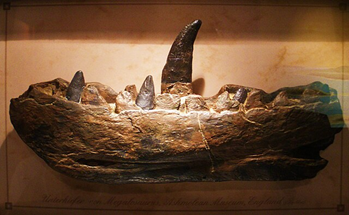The story of a local legend who fought for workers’ rights, decent housing and against fascism.
‘When the police arrested Abe in Oxford once, they asked him his name and he said. ‘You’ll never believe me, but it’s Lazarus.’ The police said, ‘What is your first name?’ He said ‘Abraham’, and they said ‘Liar’. ‘There you are,’ said Abe, ‘I told you you wouldn’t believe me, put down Bill Firestone.’ So they did.’ Arthur Exell.
Abe Lazarus was one of the most colourful people Oxford has ever seen. Olive Gibbs in her autobiography described him thus. ‘In all my years in political life, I have never met anyone with a more magnetic personality than Abe. Of medium height, with flaming red hair and startling blue eyes, his ringing voice could be heard without the aid of a microphone, from one end of St. Giles to the other. It is said the dons at St. John’s used to tremble over their port as he prophesied a workers’ revolution in this country.’
Abe was a Communist Party of Great Britain organiser and a member of the Transport and General Workers Union, sent to Oxford from the South Midlands. Born in 1911 in London into a Jewish family, his mother was Irish and spent Abe’s early years nursing him through rheumatic fever. His father worked in horse-racing. Until the age of fifteen he attended Arlington Park College and became a mechanic. He experienced unemployment which brought him in contact with the National Union of Unemployed Workers established by the Communist Party in 1921. He joined the Communist party of Great Britain in 1930 and was involved in organising the many hunger marches of the time. He found employment at the Firestone Tyre company in Brentford where in 1933 he led a six week strike which though unsuccessful did recruit substantial numbers to the Transport and General Workers Union and won union recognition. There he gained the nickname Firestone Bill.
The shattered economy of the post-war period and the rise of competing industrialised nations created huge areas of mass deprivation and hunger in the industrial areas of Britain including the South Wales valleys. Many young miners came to Oxford, substantially from the Garw Valley, often walking all the way. Driven by unemployment, starvation and often black-listing (many miners were punished for their actions in the General Strike of 1926), they were drawn to the new jobs available at the car factory in Oxford established in 1919, Morris Motors and 1926, American Pressed Steel. Arthur Exell, who worked closely with Lazarus, walked to Oxford at sixteen and saw two young men die on the way. He had watched his father driven out of work for his trade union activities. ‘There wasn’t a ha’penny coming in. That was when I learnt what suffering from hunger was. It was terrible.’ The General Strike was viewed with lukewarm support by the new Labour Party Leadership. The joining of a National Government in 1931 by leader Ramsey MacDonald split the party. MacDonald was made Prime Minister and became associated with its cutting of the benefits of insured workers by 10% and the introduction of the hated Means Test. These moves provoked outrage and many activists joined the Communist Party. The Labour Party was seen as ‘selling out’ and the need for revolutionary change was inspired by the Russian Revolution. The capitalist system was root and branch responsible for the misery in Britain.
We tend today to view the Communist Party through a filter of the Cold War and Khrushchev’s revelations about Stalin in 1956. At the time it was seen by many as an inspiration and beacon of hope. A cadre party which only recruited activists, its members were self-educated, intellectual and passionate to the extent that everything else in their lives was secondary. Their active efforts to create better conditions for workers and analyses of the systemic conditions which created poverty and ill health against a background of rapid improvements in the Soviet Union for the working class encouraged many to join. And they knew how to organise. The connections with the USSR were problematic however and in 1929 the Comintern which connected Communist parties globally called for a change in alliances. Now local parties were to view the Labour Parties and other parties seen as progressive as much as enemies as right wing parties. This could have undermined the links between the Oxford Labour Party and the Communist Party. However, in Oxford, neither side went along with this. Lazarus was skilled at weaving alliances and worked to also bring together the academic and worker sides of Oxford. He met with students and dons and with his charm and intelligence made himself popular with many. He married Mabel Browning, a student from St. Hilda’s College in 1937.

Oxford was a small town, encircling the University prior to the car factories arriving. This was a transformative time for the city. Lord Nuffield, William Morris, said he would never permit trade unions to form. However a major strike took place at Pressed Steel in 1934 where the automated line paid piece-work, reducing workers’ pay. In addition conditions were dangerous. Arthur Exell wrote, ‘It was a terrible factory to work in, dark, filthy and noisy.’ A fourteen-hour day was not unusual and safety concerns minimal. In a heatwave in July 1934 workers walked out. Women in the press shop were prominent in calling for a strike. Soon 600 were out, the biggest strike since the General Strike of 1926. The strike committee formed from members of the Transport and General Workers Union (TGWU) and included a majority of Welsh. It was led by Tom Harris and Dai Huish. The committee felt they needed leadership and knew of Abe Lazarus by reputation. Ruskin College students met him at the station and supported him thereafter. He gave a rousing speech to the strikers. Exell recalls, ‘I’d never heard anyone like him before. He spoke chiefly about the profits the boss was making…and yet paying us low wages.’ Lazarus made many speeches to people massed in St. Giles of a kind no-one in Oxford had heard before. The strike was a vicious fight. Workers road bicycles slowly in front of scab busses, boarded them and threw bricks and broke windows. Soldiers were brought in from Aldershot to disrupt the picket lines. The skilled workers’ union the Automated Engineers Union (AEU) only joined the strike in the last two days. Eventually management gave in and the hourly rate agreed and trade union recognition conceded. This was widespread in its repercussions. Locally it led to union recognition for bus workers, commercial transport and Lucy’s. Nationally the strike led to further strikes for union recognition in the newly developing industries around Britain. Lazurus’ reputation soared.
Meanwhile problems on the Florence Park estate were increasing in 1934. The estate housed many workers and was sometimes called Little Wales, not meant flatteringly as Welsh people were met by much hostility in Oxford. Built by N. Moss and Son, the houses were shoddy, built on marsh and were damp. Roads were left unbuilt and doors fell off their hinges. Arthur Exell invited a small group of residents to his house in Cambell Road and they decided to co-opt Abe Lazarus. Meetings took place most evening and leaflets were produced, the Oxford Mail contacted. Lazarus notably ran a well organised and thought through campaign. He held meetings outside the house of Moss’s agent and a mass meeting was held at the Town Hall which the committee refused to pay for as they said it was the people’s Town Hall. A deputation, including Lazarus, went to meet the Minister of Health, Sir Kingsley Wood, who told Oxford City Council to investigate the complaints. They refused and a rent strike was organised. Rents were collected and paid into a special account. Moss refused to reduce his rents and threatened evictions which he carried out. Ultimately Moss left Oxford and the new owner undertook the repair work. Lazarus stood for election several times in the local Cowley and Iffley ward where he narrowly failed to be elected with in 1936 with 1,476 votes.
Support for the Florence Park rent strikers came from people in Cutteslowe and was returned in later years. Slum houses were cleared in St. Ebbes and a council estate built in Cutteslowe, North Oxford. Peter Collinson notes that three times more people in this area were middle class compared with the rest of the city. Mssrs. Saxton, Shaw, Brown and Co. planned to build a private estate but were concerned by the Cutteslowe development. They decided to build a wall across explaining that the people living there were of ‘entirely different social status.’ Fences, then walls went up across Wentworth and Carlton Roads forcing residents to take a long way round. A meeting of 1,200 people was held in the Town Hall presided over by Labour Councillor Patrick Gordon Walker. Lazarus and supporters from Cowley, trade unions, Labour Party and Communist party members, many students from the university, Ruskin College and politicians attended in outrage. Lazarus told the assembled that they would smash the walls down themselves. He organised a much publicised meeting for Saturday 11th May 1935 on the Cutteslowe side with a band and drama from the Oxford Red Players. Two thousand attended. On the day, Lazarus and a colleague wielded pickaxes and made for the wall. They were met with police who told them they would be arrested. The Cutteslowe tenant’s association decided in future their approach would be non-political. Eventually the walls were removed by the Council in 1938. They were then replaced. They didn’t come down until 1959. This was a defeat for the campaigners but fuelled the fire for other struggles.
Fascism was rearing its ugly head. In Germany, Hitler became Chancellor in 1933 by legal means. In Spain, Franco came to power in 1936 and a brutal civil war took place until 1939. Many Oxford citizens went to fight on the side of the democratic republic. Fascism meant a move against democratic institutions, trade unions, free speech and involved brutal treatment of all opposition and in Germany, Jewish people. Lazarus and the Communist Party played a major role in the anti-fascist struggles in Oxford and the strong alliance with a very left-wing Labour Party meant their campaigning could be effective. In Oxford, there was strong support for the Republican side in Spain. In the early 1930s the British union of Fascists claimed 100 members and described Lord Nuffield as ‘our chief backer’. He gave them £85,000 but no more public support after 1932. Meeting were held by both sides in the Town Hall. Mosely came to Oxford and spoke. When he returned again in 1936 he was met with strong opposition from the political parties, students, the Trades Council, car and bus workers. The Oxford Mail described the meeting addressed by Mosely as ‘The Battle of Carfax’. Olive Gibbs remembers ‘…anyone in the audience daring to venture a contradictory viewpoint was summarily and with unbelievable brutality ejected.’ Elizabeth Pakenham describes Basil Murray, a Liberal and journalist who later covered the Spanish Civil War from the Republican side, making interjections and when he would not stop, ‘Mosley gave a sign to the posse and Blackshirts moved forward and seized Basil. The bus drivers picked up the chairs and bashed the posse over the head with the chairs. You couldn’t see across the hall as it was swirling with dust.’
Lazarus was not actually at the meeting but he was in the thick of organising opposition to Mosely who never returned to Oxford after his defeat in Cable Street, London. Lazarus continued to work in Oxford where in 1945 he gained 2000 votes in the Cowley and Iffley Ward elections. His ill-health was catching up with him though with the demands made on his time and energy in travelling around the country. He conducted a troubled affair with Inez Hill, wife of historian Christopher Hill. He remained working for the Communist Party even after the Khrushchev’s revelations about Stalin to the 20th Party Congress and the brutal Soviet repression of an uprising in Hungary. Many party members left at this stage despite their admiration for the crucial role the USSR played in the Second World War leaving 20 million dead. By now the British CPGB followed Stalin’s idea that socialism could be achieved through parliamentary means and peacefully and published the British Road to Socialism in 1951. Soon after this Lazarus gave up his position as a Communist Party full time organiser. He became a librarian in the Bernal Peace Library, part of the Marx Memorial library in London. He married again and died in 1967.
Useful reads: The Politics of the Production Line Autobiography of an Oxford Car Worker Arthur Exell A History Workshop pamphlet; The Cutteslowe Walls Peter Collinson Faber and Faber; Our Olive The autobiography of Olive Gibbs Robert Dugdale; Abe Lazarus and the Lost World of British Communism Geoff Andrews History Workshop Journal 83; NO OTHER WAY- Oxfordshire and the Spanish Civil War Chris Farman, Valery Rose and Liz Woolley; From South Wales to Oxford Miners and their families travel to find work in Oxford in the 1930’s Museum of Oxford Searchers Group.
My father, John Hughes, joined the Communist Party as a teenager. Although he left in 1956 the dedication continued and he devoted his life to the Labour movement as a tutor and later principal of Ruskin College. He worked closely with Arthur Exell and many other activists at the car factory.
Written by Katherine Hughes. Previously tutor, Ruskin College. Now running Learning Groups at the Museum of Oxford.
Want to write your own Oxford-inspired post? Sign up as a volunteer blogger.



